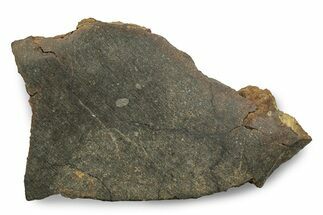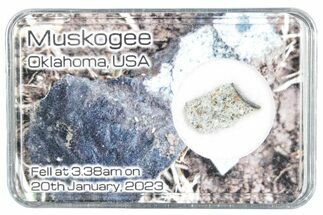This Specimen has been sold.
1.13" Gao-Guenie Meteorite (18.53 g) - Witnessed Fall
This is a 1.13" wide (18.53 gram) fragment of the Gao-Guenie meteorite that fell in Burkina Faso in 1960. Over 80 percent of its surface is covered in fusion crust: a rare and spectacular find!
The Gao-Guenie Meteorite
The Gao-Guenie meteorite is an H5 ordinary chondrite that fell over Burkina Faso at 5:00 PM on March 5th, 1960. Its fall was one of the largest observed meteorite showers ever seen over Africa. The fall was spread over a strewn field of 70 square kilometers. The meteoroid broke into thousands of smaller fragments in the atmosphere, so its total mass is unknown: however, about 1,000 kilograms have been recovered to date.
For about 40 years since its observed fall, Gao-Guenie was believed to be two separate meteorites: Gao, which was given the official fall date, and Guenie, which was purported to have fallen about a month later. In 1998 a research paper revealed that the two meteorites were virtually indistinguishable from one another, so the two were combined into the now known Gao-Guenie.
Gao-Guenie is classified as an H5 bronzite-olivine chondrite.
The Gao-Guenie meteorite is an H5 ordinary chondrite that fell over Burkina Faso at 5:00 PM on March 5th, 1960. Its fall was one of the largest observed meteorite showers ever seen over Africa. The fall was spread over a strewn field of 70 square kilometers. The meteoroid broke into thousands of smaller fragments in the atmosphere, so its total mass is unknown: however, about 1,000 kilograms have been recovered to date.
For about 40 years since its observed fall, Gao-Guenie was believed to be two separate meteorites: Gao, which was given the official fall date, and Guenie, which was purported to have fallen about a month later. In 1998 a research paper revealed that the two meteorites were virtually indistinguishable from one another, so the two were combined into the now known Gao-Guenie.
Gao-Guenie is classified as an H5 bronzite-olivine chondrite.
About Chondrites
Chondrites are stony (non-metallic) meteorites that have not been modified by either melting or differentiation of the parent body. They are formed when various types of dust and small grains in the early Solar System accreted to form primitive asteroids. Some such bodies are captured in the planet’s gravity well and pulled to the surface. They are by far the most common type of meteorite, representing about 86 percent of all meteorites that have fallen to Earth.
Prominent among the components present in chondrites are the enigmatic chondrules, millimeter-sized spherical objects that originated as freely floating, molten or partially molten droplets in space; most chondrules are rich in the silicate minerals olivine and pyroxene. Chondrites also contain particles of various metals such as nickel, iron, and aluminum. These formed at the very beginning of the solar system and aggregated over time: they are the oldest rocks known on Earth!
Chondrites are divided into about fifteen distinct groups on the basis of their mineralogy, bulk chemical composition, and oxygen isotope compositions. The various chondrite groups likely originated on separate asteroids or groups of related asteroids. Each chondrite group has a distinctive mixture of chondrules, refractory inclusions, matrix (dust), characteristic chondrule sizes, and other components. Other ways of classifying chondrites include weathering and shock. The L chondrite group is the most common of these.
Chondrites are stony (non-metallic) meteorites that have not been modified by either melting or differentiation of the parent body. They are formed when various types of dust and small grains in the early Solar System accreted to form primitive asteroids. Some such bodies are captured in the planet’s gravity well and pulled to the surface. They are by far the most common type of meteorite, representing about 86 percent of all meteorites that have fallen to Earth.
Prominent among the components present in chondrites are the enigmatic chondrules, millimeter-sized spherical objects that originated as freely floating, molten or partially molten droplets in space; most chondrules are rich in the silicate minerals olivine and pyroxene. Chondrites also contain particles of various metals such as nickel, iron, and aluminum. These formed at the very beginning of the solar system and aggregated over time: they are the oldest rocks known on Earth!
Chondrites are divided into about fifteen distinct groups on the basis of their mineralogy, bulk chemical composition, and oxygen isotope compositions. The various chondrite groups likely originated on separate asteroids or groups of related asteroids. Each chondrite group has a distinctive mixture of chondrules, refractory inclusions, matrix (dust), characteristic chondrule sizes, and other components. Other ways of classifying chondrites include weathering and shock. The L chondrite group is the most common of these.
TYPE
H5 Chondrite
LOCATION
Burkina Faso
SIZE
1.13 x .87 x .74", 18.53 grams
CATEGORY
ITEM
#265672
 Reviews
Reviews












